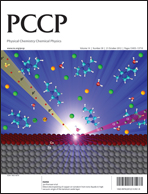A class of transition-metal-centered aromatic boron wheels (Dnh-M©Bnq−) have been recently produced and characterized according to an electronic design principle. Here we investigate the interplay between electronic and geometric requirements for the molecular wheels using the case of VB10−, which is isoelectronic to the decacoordinated molecular wheels, Ta©B10− and Nb©B10−. Photoelectron spectra of VB10− are observed to be broad and complicated with relatively low electron binding energies, in contrast to the simple and high electron binding energies observed for the molecular wheels of its heavier congeners. An unbiased global minimum search found the most stable isomer of VB10− to be a singlet “boat”-like structure (C2), in which the V atom is coordinated to a quasi-planar B10 unit. A similar triplet C2v boat-like isomer is found to be almost degenerate to the C2 structure, whereas the beautiful molecular wheel structure, D10h-V©B10−, is significantly higher in energy on the potential energy surface. Therefore, even though the VB10− system fulfills the electronic requirement to form a D10h-M©B10− aromatic molecular wheel, the V atom is too small to stabilize the ten-membered boron ring.

You have access to this article
 Please wait while we load your content...
Something went wrong. Try again?
Please wait while we load your content...
Something went wrong. Try again?


 Please wait while we load your content...
Please wait while we load your content...